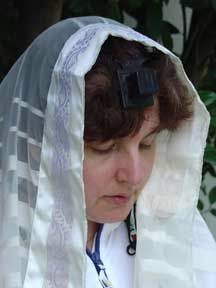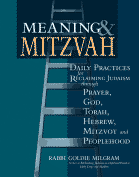How are Tefiillin made?
Tefillin are a set of two leather boxes filled with parchments on which a scribe has written specific verses from the Torah, then attached the boxes to leather straps, each knotted so that one can go around your head and one around your weaker [non-dominant] arm. It is quite complex to make Tefiillin, and one is best served by buying good quality ones made by a scribe. The term tefillin (Aramaic) shares the root of tefillah, prayer.
The same verses are in each box, only the ones on the arm [shel yad] are on one parchment, and those for the head [shel rosh] are done on four parchments and each paragraph gets its own room in the little bayit [house-like box].
In the paragraph after the Shema, we read the section that most clearly describes the basis for Tephillin. Tephillin also contain verses from Deuteronomy 6:4-9 and 11:13-21, and also Exodus 13:1-10 and 13:11-6.
"...you shall bind them for a sign upon your arm and they will be for frontlets between your eyes." Deut 6:8
How to Put On Tefillin:
Each step of Tefiillin (tephillin, alt. spelling) practice has meaning. By putting the "shel yad" on your weaker arm, the message is for this mitzvah to strengthen you. By the way, Tefillin are worn only during the day, and not on Shabbat, and never in the bathroom - they have real Torah inside! They're not only expensive, they can be damaged by moisture, extreme temperature and misuse. If you're using an inherited set, check with a Judaic shop or a scribe to see if they need maintenance.
Note: There are videos on line that show how to wrap tefillin.
l. The shel yad is first. While standing, unwrap the coiled straps, leaving any knots or straps that have been slipped through a knot in place. Take off the little silver metal or cardboard box that protects the bayit [house-like box].
2. Pull up your sleeve (or wear short sleeves) and open the leather loop wide so you can slide your arm in and tighten the loop over your biceps. The knot ought to be touching the bayit, many have the bayit pointing somewhat toward the heart, which is part of the point of this practice, connecting your heart to the mitzvot and the Source of Life.
3. Say the first blessing, baruch atah adonai eloheynu melech ha olam asher kidshanu b'mitzvotav v'tzivanu l'hanee-akh tefillin, which ends with "that guides use to holiness through mitzvot (mitzvah-centered living), by putting on tefillin."
4. If you don't have a large bicep, it will help to wind above and below the bayit (house/box) on the flat edge underneath the box to hold it in place. Most females need to do this or everything falls down around the wrist, most men can just do one additional turn on the bicep.
5. Now wrap seven times around your lower arm, some communities have the custom of wrapping toward the body, others away. Each of the seven turns has a meaning, there are many interpretations. I like to think of each turn as one of the seven qualities the Jewish mystics believe are like a hologram, happening inside of us and the Big Picture of the Universe as we do it. These seven qualities are:
Chessed: Unconditional loving-kindness.
Gevurah: Strength and discipline.
Tiferet: The beauty that is compassion.
Netzach: Endurance, ambition, drive, focus.
Hod: Working on the quality of something in your life, containment.
Yesod: Transmitting, sending something on that is ready.
Malchut: Letting go of control, see what will be after you've done all you can to prepare.
6. Wind the rest of the leather strap around your palm, you'll get back to it.
 7. Take the slip on covering off of the box of the bayit of the shel rosh (head piec), and put it over your head so that the box sits just below your hairline, the knot behind your head just above your neck. Let the two straps hang loosely on either side of your head, over your shoulders.
7. Take the slip on covering off of the box of the bayit of the shel rosh (head piec), and put it over your head so that the box sits just below your hairline, the knot behind your head just above your neck. Let the two straps hang loosely on either side of your head, over your shoulders.
8. Recite the second blessing, barukh atah adonai eloheynu melech ha-olam asher kidshanu b'mitzvotav vitzivanu al mitzvat tefillin--that guides us to become holy through the mitzvah of tefillin. There are meditations for now in many prayer books, one often printed asks G*d to fill you with wisdom and to satisfy the desires of all living things.
9. Now keeping the seven windings in place on your arm, unwrap the length of strap around your palm and bring it over the top of your hand between your thumb and pointer finger down to the middle finger.
10. Wrap three times around the middle finger and then go back around your palm until you've used up the slack and can tuck the end in. The picture below shows how you end up with one of the sacred names of G*d - Shaddai - "Nurturing One," Shin, Daled, Yud, about which the sage the Tashbatz 3:118 indicates is a way of wrapping that originated in Spain.
11. The blessing that is said now is the same one from the prophet Hosea that is said at a Jewish weddings, because tefillin is a commitment between you and the Source of Life, with each of the seven windings being like a journey to prepare yourself for this moment in every week day.
V'eirastikh li l’olam I am engaged with You forever.
V’eirastikh li b’tzedek I am engaged with You in justice.
U’v’mishpat and I will stay with You to get it right
U’v’khessed and with loving-kindness
U’v’rakhamim and with compassion
v’eirastikh li b’emunah I have faith in this relationship
v’yahdaht et Adonai Though me, You will know God.
Sometimes people rest their head on their arm while praying or thinking, connecting the head and the arm tefillin that is adjacent to the heart.
After you've finished your morning prayers you can take your tefillin off or keep them on for a time of meditation or Torah study. Some of our sages and their students were known to keep them on all day! When you take them off, first remove the strap around your fingers, then wind it around your palm, take off the shel rosh [head set], wrap it up with its covering box back in place, put it away in the tefillin bag, take off the rest of the shel yad and pack it up too.

Learn more about Torah
from a spiritual perspective in
Meaning & Mitzvah: Daily Practices
for Reclaiming Judaism
through Prayer, God, Torah, Hebrew,
Mitzvot and Peoplehood
by Rabbi Dr. Goldie Milgram
Photo: Rabbi Goldie Milgram wearing tefillin and tallit. Photo Credit: Barry Bub (c) 1998